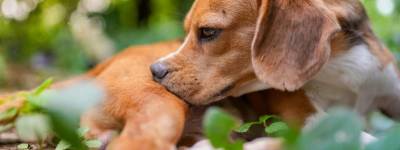Dog Dandruff. Causes and Tips to Treat it.

The term ‘dog dandruff’ might come as a surprise to many, but just like people, our four-legged friends can also develop this condition. While this isn’t usually something to worry about, the presence of dandruff in dogs can be a sign of other underlying health issues. It’s also unsightly for us, and more importantly, often quite uncomfortable for them.
At the end of the day, skin irritation is quite distressing, regardless of the species in question.
So, if you’ve recently noticed those pesky white flakes showing up on your dog’s coat, we have some tips on how to deal with the problem while also significantly improving your pet’s well-being.
What causes dandruff in dogs?
Dandruff is a relatively common and manageable condition in pets which is triggered by their sebaceous glands that produce skin oils. Seborrhoea, or the production of too much oil by these glands, causes a skin imbalance, resulting in the small flakes of dried skin known as dandruff. The condition can also be caused by the opposite effect, the production of too little oil, which triggers a similar imbalance and skin irritation. Here are the most common factors, from among many, that can set this problem in motion.
An unhealthy diet
As for humans, nutrition plays a vital role in your pet’s well-being. So, if they don’t get enough vitamins, water, or fatty acids, all of which are essential for healthy skin, their coat is more likely to suffer, which could eventually result in dandruff.
Under- or over-grooming
Who doesn’t like to spoil their furry friends with the occasional pampering? However, the keyword here is ‘occasional’ – bathing your pooch too often or not bathing them as often as required can also result in unhealthy skin.
Low humidity levels
Living in a dry climate can take its toll on your dog’s coat; when there’s not enough moisture in the air, it can cause your dog’s skin to dry out. This is also the reason why skin conditions usually become exacerbated during colder months.
Seasonal or environmental allergies
If your dog is young and doesn’t have any other issues except for the dandruff, they might either have a seasonal allergy or an allergy to something in their environment. In either case, booking a visit to a trusted vet will help you get the right diagnosis as well as a dog dandruff treatment, if needed.
Bacterial and fungal infections
Dandruff in dogs can also be the result of infections. This would definitely require a visit to the vet as it’s important to pinpoint if the origin is bacterial or fungal so that you can get the appropriate treatment for the condition.
What are the most common symptoms of dog dandruff?
Dandruff is pretty easy to detect. Once you notice these white flakes clinging onto your pet’s fur, your first step should be to thoroughly inspect their skin. If they’re constantly licking, biting, or scratching at their skin, you should notice red patches caused by the irritation. In some cases, there might also be an odour, as well as dogs/health/skin-fur-ears/alopecia-on-dogs">hair loss or the presence of scabs. One thing to remember is that whenever your dog displays any unusual behaviour or seems distressed, the right call is always to look into the problem to try and find the cause.
Which dog breeds are more prone to dandruff?
In general, any dog can develop dandruff, and most will develop it seasonally, but there are certain breeds that are genetically predisposed to having flaky skin. These are dogs that are either medium- or long-haired and include:
- Golden retrievers
- Cavalier King Charles spaniels
- Yorkshire terriers
- Jack Russell terriers
- Norfolk terriers
What’s a good dog dandruff treatment?
While you won’t be able to share your own anti-dandruff shampoo with your dog, there are a few solutions to help you deal with this issue. First on your list of priorities should be providing them with a better diet to make sure that your furry best friend gets all the necessary vitamins they need to be happy and healthy.
Another efficient dog dandruff treatment is the use of a humidifier in your home which will ensure that your pet’s skin will stay moisturized, helping them to stop shedding skin flakes.
Additionally, since their usual grooming routine might also be causing the dandruff, it’s a good idea to try changing it up a bit to see how the dog’s skin reacts to a little more or a little less grooming.
If you’ve already tried everything and you’re seeing no results, it would be best to visit your vet and seek their advice. Hopefully, the dandruff will be gone in no time and your pooch can get back to being their old cheery self as soon as possible.


